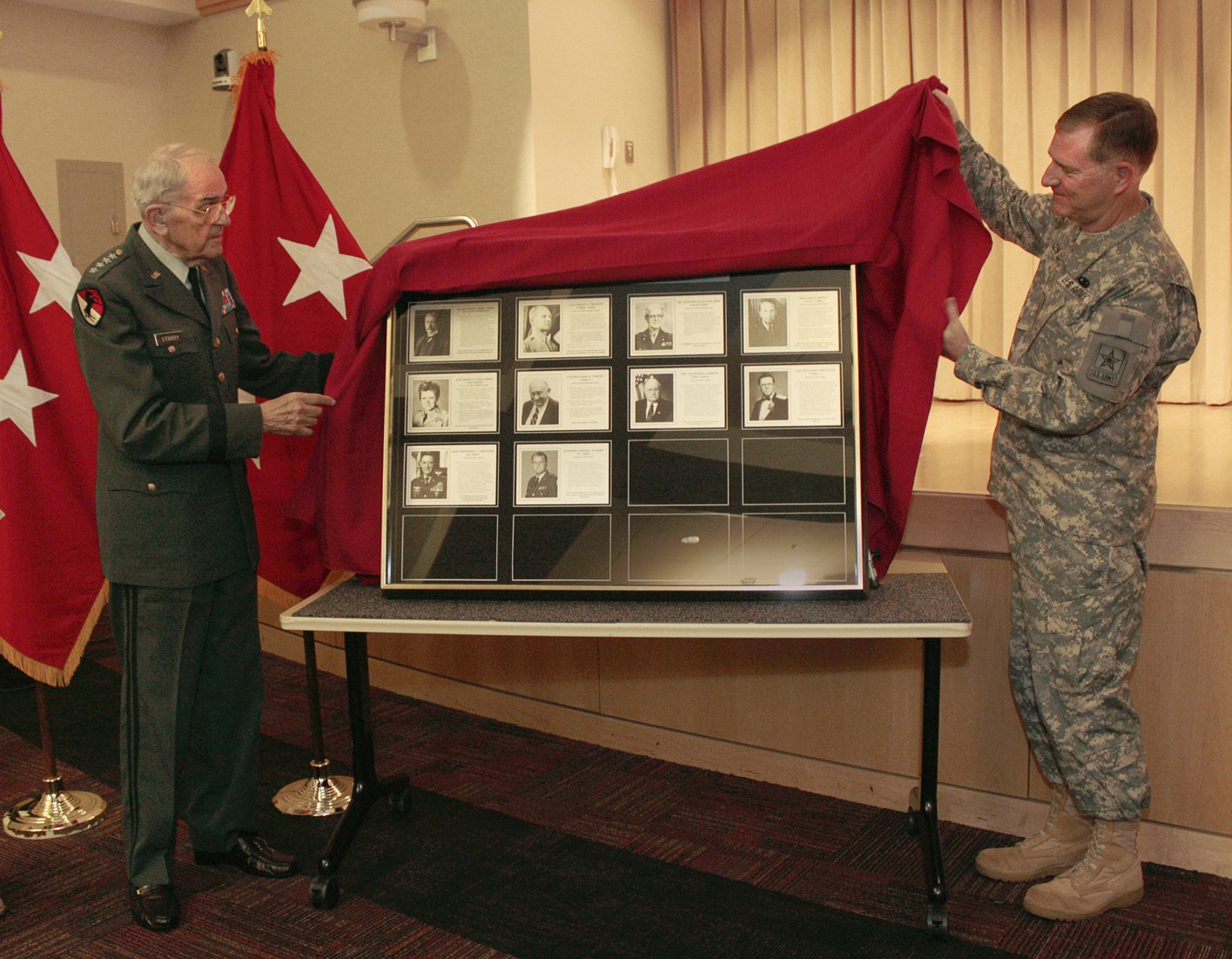
WASHINGTON (June 23, 2010) -- Retired Gen. Donn A. Starry is considered to be the architect of the 1980s' Air-Land Battle Doctrine, which transformed how the Army fights conventional wars. Even though he retired more than 25 years ago, his lasting contributions to the Army were recognized recently.
Starry, who earned the Silver Star, the Bronze Star Medal with "V" device, the Soldier's Medal, and the Purple Heart, during two tours in Vietnam, was inducted into the U.S. Army Force Management Hall of Fame June 15, at a ceremony in the Pentagon.
Lt. Gen. Robert P. Lennox, the Army deputy chief of staff, G-8, and host for the ceremony, explained in his remarks why Starry is recognized as a Force Management trailblazer.
"Force Management is the formal process the Army uses to define warfighting requirements specifically, to develop new equipment and personnel, and combine them all into combat-ready units," said Lennox. "Much of this process came directly out of the top-to-bottom reorganization of the Army that great leaders like General Starry and (Lieutenant) General (Richard G.) Trefry put in place in the 1970s and 1980s. Sir, to my generation you are not only an inspiration, you are a legend."
Starry told the crowd of more than 150 attendees that he was once given three missions by then-Chief of Staff of the Army Gen. Creighton Abrams during the Army's post-Vietnam period. He said he took those missions seriously, and most of the doctrine he wrote throughout his career was the result of trying to accomplish those missions.
"He told me to write a book about armor combat in Vietnam," Starry said. "He told me to make sure we were not screwing up the tank program. He told me to get the Army off its ass."
Taking lessons learned from Vietnam and the Yom Kippur War, Starry became a driving force behind Air-Land Battle Doctrine, which changed how the Army equips its units, trains its Soldiers, and fights on the conventional battlefield.
"Doctrine is the first and most important commandment," Starry explained. "The secret to a good Army is having a sound set of doctrine. Sound doctrine makes well-trained Soldiers. Sound doctrine makes well-trained leaders. Sound doctrine makes well-trained units."
Starry, a 1948 graduate of the U.S. Military Academy at West Point, Gen. William Depuy, and other strategic planners from that era, developed the collection of processes now called Force Management, to bring the Army out of its post-Vietnam decline, said Fleitz. The Army of the 1970s was demoralized, poorly trained, and focused on a strictly defensive mindset, which was heavily dependent on the use of tactical nuclear weapons.
Force Management and Air-Land Battle doctrine were used to determine how the Army would fight the next war, how the Army would identify and field the proper weapons systems, and how the Army would ensure properly-trained Soldiers were distributed throughout the force, Fleitz explained. The goal of this process was to combine all these factors to build the most combat-effective Army the world had ever seen.
"General Starry was developing Air-Land Battle doctrine at the same time the Army was modernizing and fielding the 'Big 5' weapon systems," Fleitz said. "He worked out how the Army could use the Abrams tank, MLRS (Multiple-Launch Rocket System), the Patriot missile system, the Apache helicopter, [and] the Bradley Fighting Vehicle together to form the offensive land force that destroyed the Iraqis' fourth-largest Army in the world, in 1991."
Starry, who commanded the 11th Armored Cavalry "Blackhorse" Regiment, during his second combat tour in Vietnam, said that modernization entailed more than buying modern weapon systems. He felt the Soldiers who were expected to become experts with that equipment must be considered.
"Everything being equal, modernizing the force -- talking about equipment -- is much easier than discussing manning the force," Starry wrote in an article presented at the 1980 Association of the United States Army Spring Banquet. "So, everyone concentrates on the former and slides over the latter. All the modernization we can do depends in the final analysis on the Soldiers who must shoulder the burdens."
Prior to retiring in 1983, Starry served 10 years in continuous command, having commanded the Armor School at Fort Knox, Kentucky; V Corps in Germany; Training and Doctrine Command at Fort Monroe, Virginia; and Readiness Command at MacDill Air Force Base, Florida. He is only the 10th person to be inducted into the U.S. Army Force Management Hall of Fame, since it was created in 2005. The Force Management Hall of Fame inducts one or two inductees every other year, said Fleitz. The next inductees will probably be named in 2012.
Force Management Hall of Fame inductees have all made significant contributions to doctrine, manning, and equipping challenges that faced the Army during their careers. They solved problems that current Functional Area 50 (FA50) and Career Program 26 (CP26), Force Management, professionals address in today's Army.
According to Bob Fleitz, a senior analyst with the FA50 Proponency Office, the Army formed the Force Management Functional Area in 1997, to create a cadre of officers who specialize in developing the force. Previously, this process was staffed by officers from the battalion level all the way up to Army Service Component commands, who might not have had any previous experience in Force Management.
FA50 Soldiers and CP26 Civilians are expert problem solvers who help commanders get the capabilities their units need to be successful.

Social Sharing